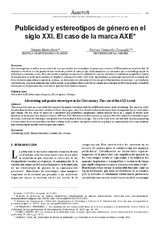Mostrar el registro sencillo del ítem
Publicidad y estereotipos de género en el siglo XXI. El caso de la marca AXE
| dc.contributor.author | Martín Brito, Damián | |
| dc.contributor.author | Comesaña Comesaña, Patricia | |
| dc.date.accessioned | 2022-09-23T12:01:22Z | |
| dc.date.available | 2022-09-23T12:01:22Z | |
| dc.date.issued | 2022 | |
| dc.identifier.issn | 1575-2100 | |
| dc.identifier.issn | 2386-4494 | |
| dc.identifier.uri | http://hdl.handle.net/10396/23994 | |
| dc.description.abstract | Esta investigación se enfoca en un estudio de caso que analiza los estereotipos de género que la marca AXE transmite en su publicidad. El objetivo es verificar si se ha producido una evolución positiva de estos ya que, tradicionalmente, es una marca que se ha distinguido por su naturaleza y contenido sexista. Para este estudio se optó por un análisis de contenido de carácter cualitativo y cuantitativo longitudinal a partir de una muestra de veinte spots emitidos en España y Latinoamérica entre 2000-2019. Apoyándonos en investigaciones previas se definió una ficha de análisis para obtener el grado de sexismo, los indicadores de estereotipos y roles de género transmitidos sus mensajes. Los resultados concluyen que, a pesar de mantener una cultura sexista, en los últimos años se percibe un cambio en el concepto creativo que permite vislumbrar una mejora en la representación y relación de igualdad entre hombres-mujeres. | es_ES |
| dc.description.abstract | This research focuses on a case study that analyses the gender stereotypes that the AXE brand conveys in its advertising. The aim is to verify whether there has been a positive evolution of these stereotypes, since it is a brand that has traditionally been distinguished by its sexist nature and content. For this study we opted for a qualitative and quantitative longitudinal content analysis based on a sample of twenty spots broadcast in Spain and Latin America between 2000 and 2019. Based on previous research, an analysis sheet was defined to obtain the degree of sexism, indicators of stereotypes and gender roles transmitted in their messages. The results allow us to conclude that, despite maintaining a sexist culture, in recent years there has been a change in the creative concept that allows us to glimpse an improvement in the representation and relationship of equality between men and women. | es_ES |
| dc.format.mimetype | application/pdf | es_ES |
| dc.language.iso | spa | es_ES |
| dc.publisher | Asociación de Estudios de Ciencias Sociales y Humanidades | es_ES |
| dc.rights | https://creativecommons.org/licenses/by-nc-nd/4.0/ | es_ES |
| dc.source | Ámbitos 47, 81-96 (2022) | es_ES |
| dc.subject | Publicidad | es_ES |
| dc.subject | AXE | es_ES |
| dc.subject | Estereotipos de género | es_ES |
| dc.subject | Rol de género | es_ES |
| dc.subject | Sexismo | es_ES |
| dc.subject | Advertising | es_ES |
| dc.subject | Gender stereotypes | es_ES |
| dc.subject | Gender role | es_ES |
| dc.subject | Sexism | es_ES |
| dc.title | Publicidad y estereotipos de género en el siglo XXI. El caso de la marca AXE | es_ES |
| dc.title.alternative | Advertising and gender stereotypes in the 21st century. The case of the AXE brand | es_ES |
| dc.type | info:eu-repo/semantics/article | es_ES |
| dc.rights.accessRights | info:eu-repo/semantics/openAccess | es_ES |

